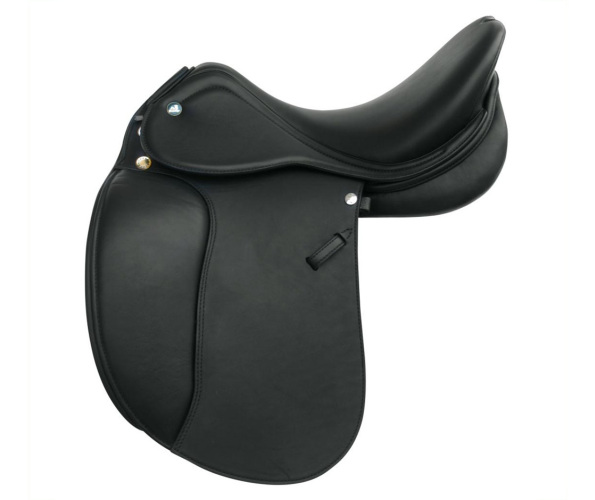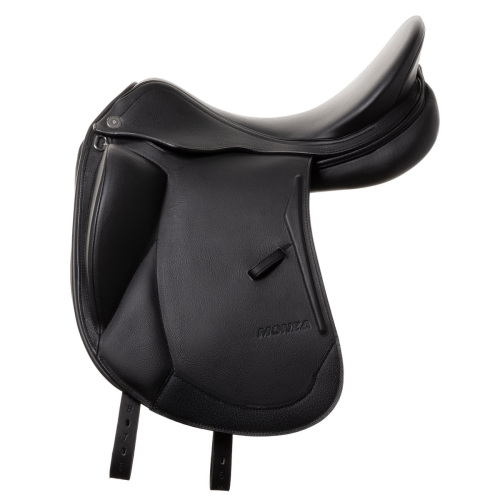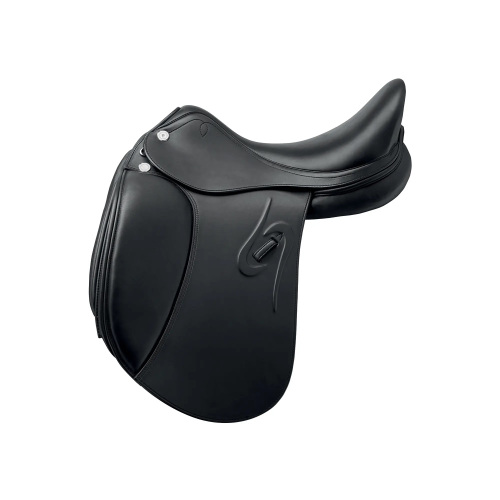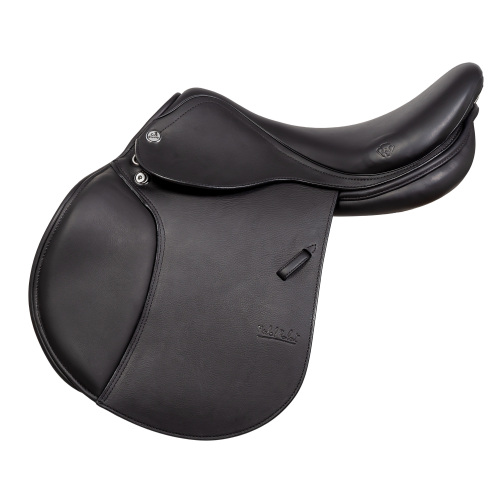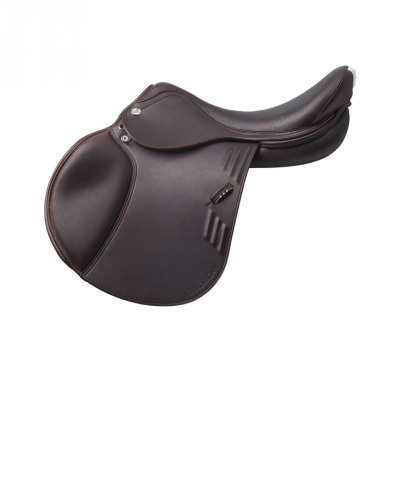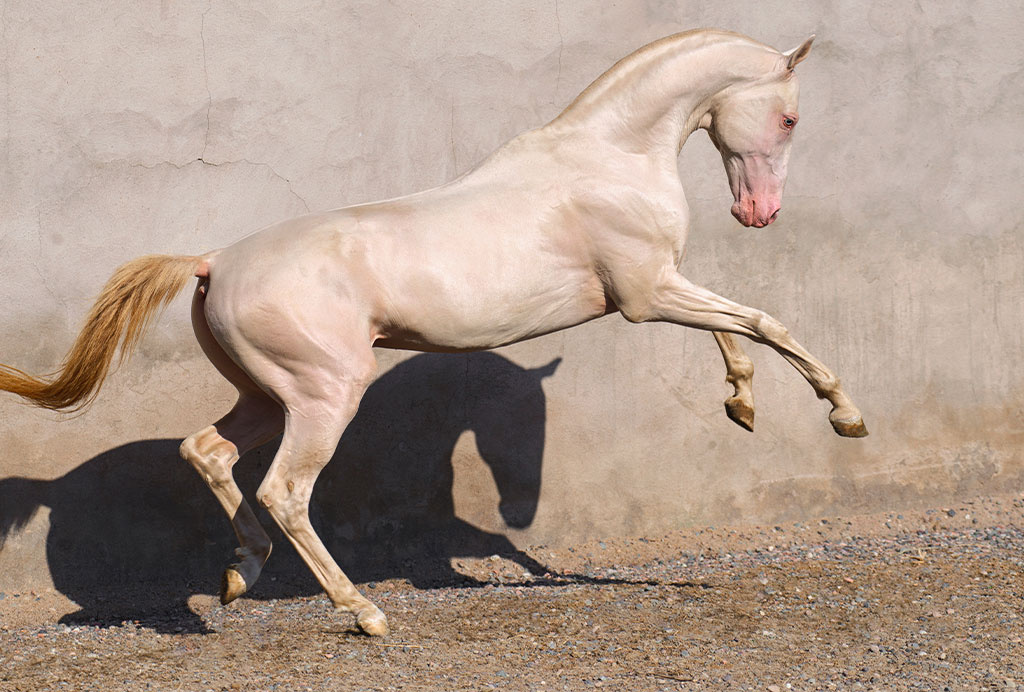
The Akhal-Teke horses were bred over 3 thousand years ago. In ancient times people called them “blood sweating horses”, golden horses”, or “heavenly horses”. It is presumed that the “blood sweat” came from parasites that lived in water drunk by these horses. A different theory says that the bloody look was caused by small veins bursting under the thin skin due to over-exhaustion.
The Akhal-Teke – breed history
The Akhal-Teke has been continuously bred for over 3000 years. This is a descendant of the Turkoman horse, known and valued especially in China. Adapted to harsh climate conditions, they are considered to be one of the oldest existing horse breeds. They are characterized by their powerful movement and great stamina that evolved over the years thanks to the breed’s participation in wartime assaults as riding horses. Those abilities now make the Akhal-Teke a versatile horse.
The first breeding of the Akhal-Teke was done by the nomadic Tekke Turkmen tribes within Turkmenistan in Asia. Akhal is the name of a line of oases along the northern slope of the Kopet Dag mountains in Turkmenistan, where these tribes lived.
However, the genesis of the breed is not fully known. The Akhal-Teke is most probably a descendant from an older breed known as Turkoman (some speculate that this is the same breed), or from Nisean horses. The exact lineage is unknown because during ancient times, people did not classify breeds as modern people do – horses were classified based on local types.
The Turkomen horses are considered to be extinct, however, there is a possibility that related horses are bred in Iran. Another interesting fact about the Turkomen horses, according to research, is that they have the same descendants as Arabians (Oriental horses). This disproves the theory that claimed Arabians were ancestors of the Turkomen horses.
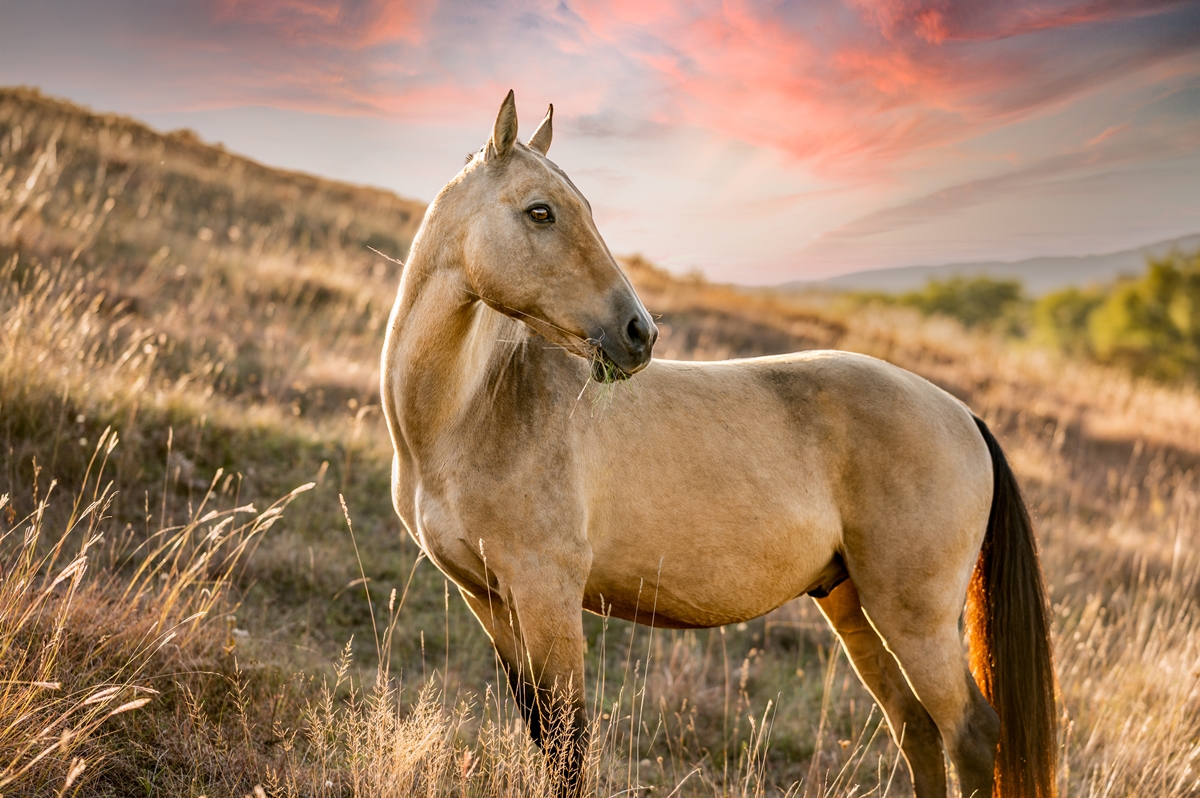
Nevertheless, the Turkomen horses vastly impacted many other breeds, including modern warmbloods. The latest research confirms that Turkomen stallions’ genes played a part in the creation of Thoroughbreds. There is also a possibility that all modern living Akhal-Teke horses have Thoroughbreds in their lineage.
Other breeds and variations that descend from Turkomen horses are Yomund, Goklan, and Nokhorli. Some historians suggest that these horses are simply different variations of the same breed. Other ancient breeds that could have influenced the creation of the breed include Massaget and Parth. At the same time, there is a theory that the Akhal-Teke descends from the original Fergana horse that was bred in the Fergana Valley in 104 B.C.
The tribes of Turkmenistan conducted selective breeding of Akhal-Teke horses and orally passed down the pedigree of the animals while also using them to invade other tribes. Mares and foals were allowed to roam freely while stallions were tied down near tents and covered by up to seven layers of fleece. This resulted in a very short and shiny coat that could reflect sunlight and blend into the sandy environment. Additionally, the method trained horses for physical activity in hot weather that occurred during invasions. The horses also had reduced food and water intake before a planned raid to prepare the animals for a harsh journey with scarce resources.
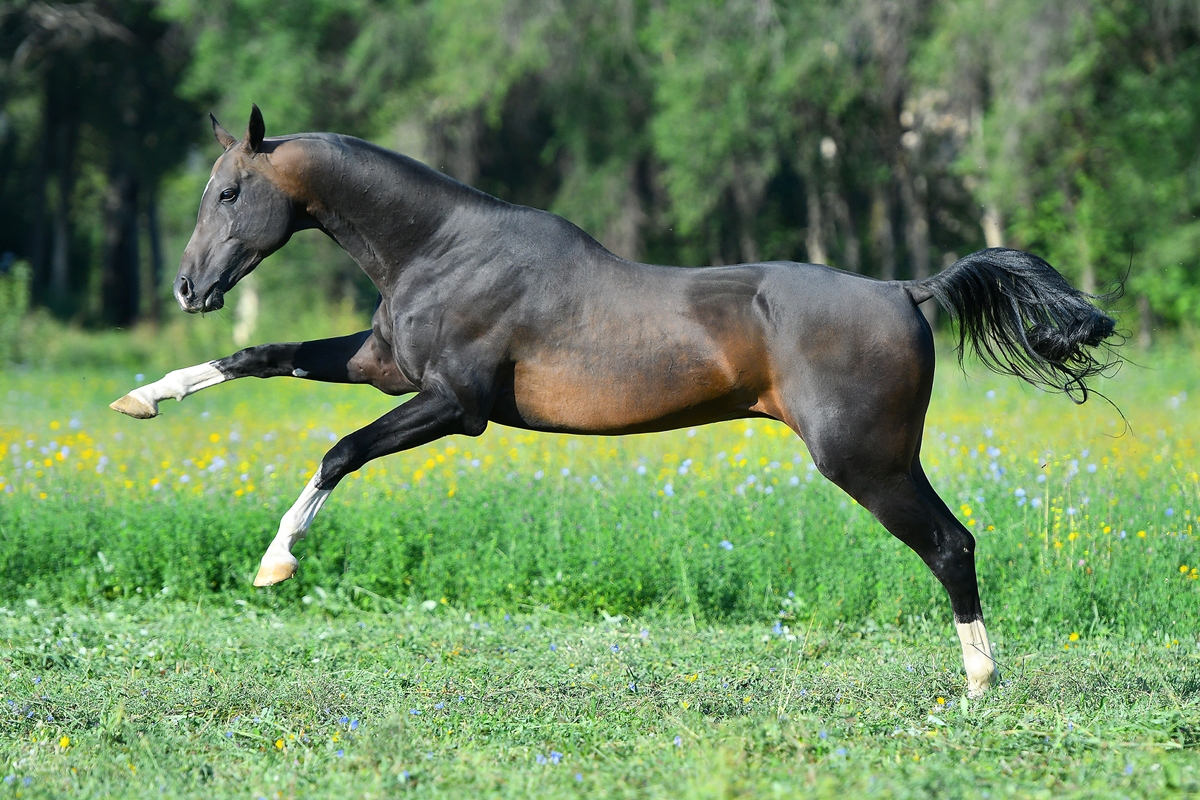
In 1921 Turkmenistan was forcefully incorporated into the Union of Soviet Socialist Republics (USSR). The Russian general Kuropatkin took a liking to the horses that he saw tribes fighting on and after the war created a breeding farm. It was the general who named the breed Akhal-Teke in honour of the tribes in Turkmenistan that lived around the Akhal oasis.
Russians called the horses Argamak which means divine or sacred horse, while Chinese people used the name heavenly horse. People valued them for their speed and stamina when travelling over deserts and their loyalty toward owners.
The stud book of Akhal-Teke horses stopped its formation in 1932. The USRR published the first register of the breed in 1941 which included over 700 horses. The breed sustained a lot of damage when the Soviet Union demanded to slaughter the horses for meat, despite the fact that Turkmen refused to consume these horses. At one point in history, the population of the breed went down to 1250 horses and the Soviet Union put a ban on the export of the Akhal-Teke horses.
These days, the government of Turkmenistan treats these horses as a diplomatic gift and sometimes auctions them to raise money that will better the breeding.
At the beginning of the 20th century, people cross-bred Akhal-Teke horses with Thoroughbreds to create a faster racing horse that could run on long distances. However, Anglo-Akhal-Teke horses were not as resilient as their counterparts and many of these horses died due to harsh conditions in Central Asia.
In 1935 people organized a race from Ashkabad to Moscow, a journey that went over 4200 km, including a 378 km – around three days – route over a desert without water. The whole race took 84 days to complete. The purebred horses finished the race with a much better result than half-breed horses. Therefore, the management of the stud book decided to declare that all the mixed breed horses cannot be regarded as Akhal-Teke.
Since 1973, all foals must have a recognized blood type in order to be written into the stud book – a practice done to ensure the preservation of Akhal-Teke genes. However, since 2014, if the parents are recognized in the papers, a foal must only have a DNA test done from a hair follicle. A stallion that does not produce quality offspring (type, characteristics of the breed) can be excluded from the breeding and stud book.
In modern days, Akhal-Teke horses are bred all around the world. Besides Turkmenistan, breeding is done in Russia, Central Asia, Europe, the USA, Uruguay, and Australia.
The Akhal-Teke – anatomy and characteristics
Akhal-Teke horses have a very fine and slim posture. Their small head with a straight profile, big eyes, and long ears is set on a close-coupled, long, and lean neck. They have characteristically elongated bodies, medium length, sometimes sloping shoulders, as well as shallow and slim chests. Withers are very prominent, and the croup is sloping. Akhal-Teke horses have strong and long legs with hard hooves (unfortunately sometimes these horses suffer conformation defects).
The most recognizable quality of this breed is the amazing, short coat with metallic shine as well as the silky soft mane and tail. These characteristics give the Akhal-Teke horses their gold and heavenly horse nickname.
Height: 145-165 cm
Weight: around 430 – 500 kg (1100 pounds)
Coats:
- Chestnut,
- Cremello (chestnut coat lightened by two copies of the Cream gene)
- Dun
- Buckskin dun (bay coat lightened by one copy of the Cream gene)
- Bay with a visible copper shine
- Black
- Grey
Akhal-Teke horses have a great predisposition for cantering. They can also move in tölt and ambling gait.
Unfortunately, these days Akhal-Teke horses suffer from genetic diseases such as naked foal syndrome or hairless foal syndrome cervical vertebral malformation (CVM), commonly called Wobbler syndrome, and degenerative suspensory ligament desmitis (DSLD), as well as cryptorchidism (lack of one or two testicles). These diseases are caused by limited genetic diversity, which raises concerns about the growing numbers of genetic disease carriers and the lack of ways to deal with them. As of right now, there are no DNA tests that could detect those diseases.
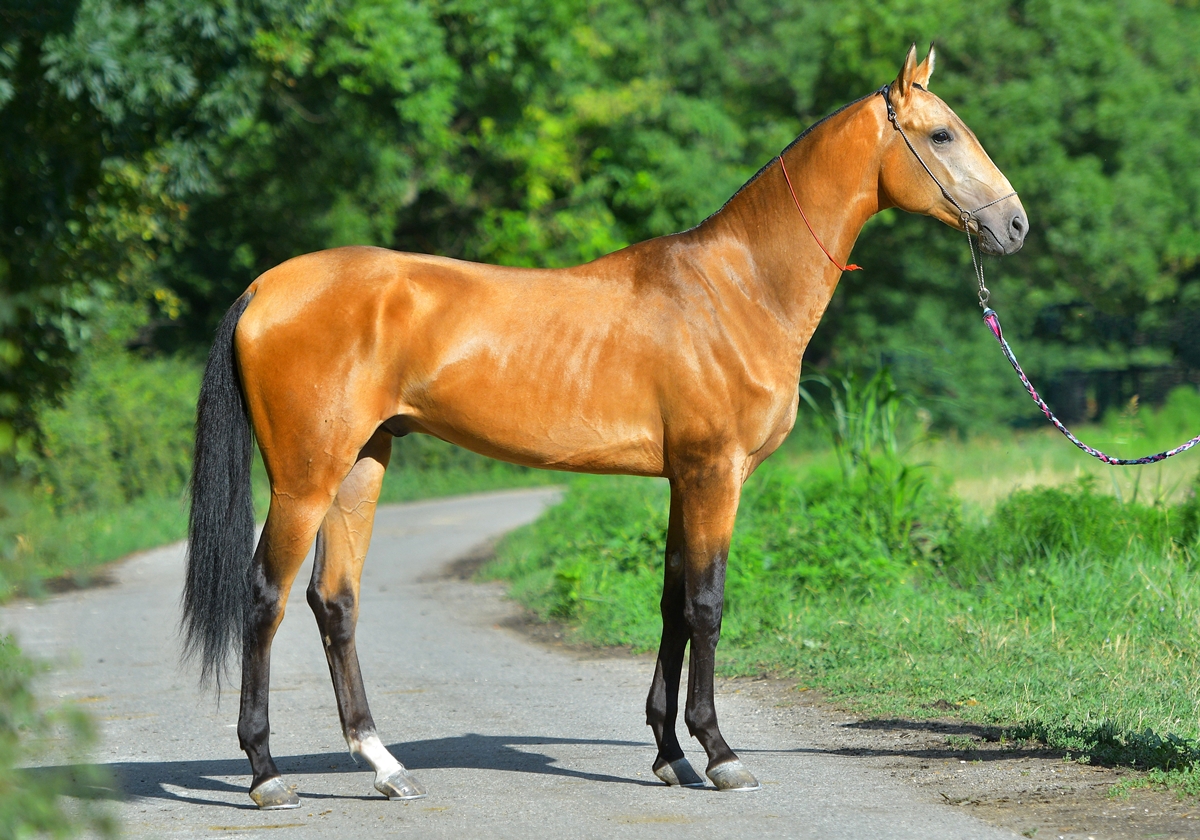
The Akhal-Teke – importance
These horses are strong, resilient, agile, intelligent, but also obedient, and eager to learn. In the past they were war horses, however today they are perfect for most equestrian disciplines. Akhal-Teke horses can be seen in dressage, racing, endurance races, eventing, and show jumping.
One dressage stallion went down in history. The Akhal-Teke stallion called Absent with Siergiej Fiłatow won the Grand Prix de Dressage during the Summer Olympic Games in Rome, in 1960 (as an 8 year old horse) as well as the individual and team bronze medal in Tokyo during the Summer Olympic Games in 1964. The same horse along with the rider Ivan Kalita helped the USRR to win the silver team medal during the Summer Olympic Games in 1968 in Mexico. What’s interesting, today he would not have been classified as Akhal-Teke due to his mother’s, Bakkara, pedigree.
In 2009, an Akhal-Teke horse named Almila went on a solitary journey with a French poet Laurance Bougaulta from Isfahan (Iran) to Paris through Turkey, Greece, and Italy. They covered 6500 kilometres in less than six months.
The Akhal-Teke – price
The price for an Akhal-teke horse starts from 30 thousand PLN (around 6 thousand pounds) and can reach even 100 thousand PLN (around 20 thousand pounds) or more. Just like in Arabians, there is no upper price limit.
Summary
An Akhal-Teke horse is a brave, extremely resilient, and nicely moving animal with a shiny coat that granted him many favourable nicknames. Throughout the years, this breed became a symbol of Turkmenistan and a national good – it appears in the national emblem and on bills. Despite the immense efforts from breeders, the future of Akhal-Teke horses is unknown due to the genetic diseases that are caused by a lack of genetic diversity. Hopefully, the efforts will sustain the breed for another 3000 years.
Take care of your horse’s back by choosing the right saddle. To get the best one visit our website: SADDLES
Equishop: +48 784 039 784
E-mail: contact@equishop.com
News from equestrian store Equishop:







